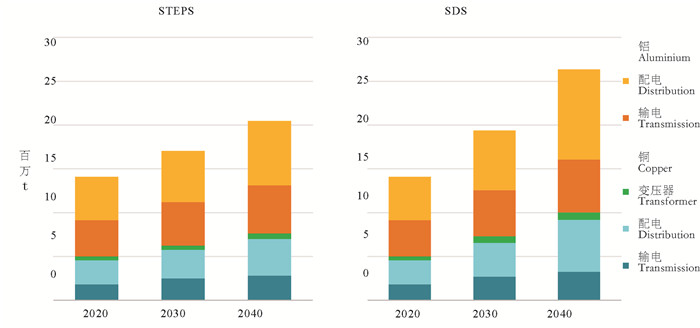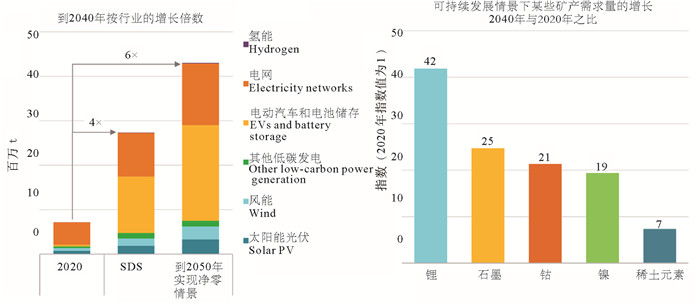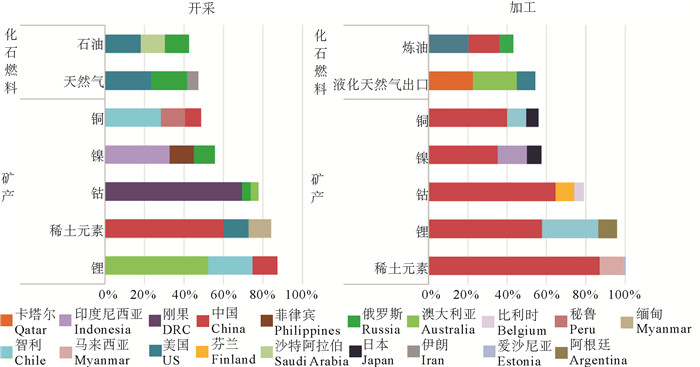The role, supply and demand of critical minerals in the clean energy transition under carbon neutrality targets and their recommendations
-
摘要:
在"碳中和"目标的驱动下,全球能源系统向清洁化、低碳化甚至无碳化发展已是大势所趋。针对向清洁能源转型的需求,采用了统计对比、分类汇总、综合分析等方法,分析研究了关键矿产在电池、电网、低碳发电和氢能等行业中的作用和需求。结合当前关键矿产产量的地理集中度高、项目开发周期长、资源质量下降等矿产供应和投资计划不能满足清洁能源转型的需求等问题,提出确保关键矿产多样性供应,推动价值链各环节的技术创新,扩大回收利用,增强供应链弹性和市场透明度,将更高的环境、社会和治理标准纳入主流程及加强生产者和消费者之间的国际合作等建议。
Abstract:Driven by the goal of "carbon neutrality", it is a general trend for the global energy system to develop towards cleaner, low-carbon or even carbon-free. In response to the demand for the transition to clean energy, the methods of statistical comparison, classified summary and comprehensive analysis are adopted to analyze and study the role and demand of critical minerals in department such as batteries, electricity networks, low-carbon power generation and hydrogen. Combined with the problems, such as high geographical concentration of current critical mineral output, long cycle of project development, and decline in resource quality, that cannot meet the needs of clean energy transition, it is proposed to ensure the diversified supply of key minerals, promote technological innovation in all links of the value chain, scale up recycling, enhance supply chain resilience and market transparency. It is suggested to mainstream higher environmental, social and governance standards into the main process, and strengthen international collaboration between producers and consumers.
-

-
图 1 2018年中国部分关键矿产对外依存度(据翟明国等,2021修改)
Figure 1.
图 2 欧盟关键矿产的主要供应国(EU,2020)
Figure 2.
图 3 某些矿产品生产的平均温室气体排放强度与一辆电动汽车和一辆内燃机车在生命周期内的温室气体排放量(IEA,2021)
Figure 3.
图 4 用于某些清洁能源技术的矿产(IEA,2021)
Figure 4.
图 5 到2050年,4DS、B2DS和REmap下能源技术(不含储能)对某些矿产的累积需求量(世界银行,2020)
Figure 5.
图 6 按情景划分的年平均电网扩建和更换需求(IEA,2021)
Figure 6.
图 7 不同情景下电网的铜、铝需求(IEA,2021)
Figure 7.
图 8 按情景划分的清洁能源技术对矿产的需求量(IEA,2021)
Figure 8.
图 9 核电的矿产需求(IEA,2021)
Figure 9.
图 10 可持续发展情景下煤炭和某些能源转型矿产的生产收入(IEA,2021)
Figure 10.
图 11 2019年某些矿产品和化石燃料产量排名前三的生产国所占份额(IEA,2021)
Figure 11.
图 12 可持续发展情景下电动汽车废旧锂离子电池及其储存、回收和再利用量(IEA,2021)
Figure 12.
表 1 关键矿产在清洁能源技术中的重要性(IEA,2021)
Table 1. The importance of critical minerals in clean energy technology(IEA, 2021)

表 2 锂电池、铅酸电池的子技术及用途(据World Bank,2020)
Table 2. Sub-technologies and applications of lithium batteries and lead-acid batteries (from World Bank, 2020)

表 3 关键矿产的应用领域
Table 3. Application fields of critical minerals

-
Argonne National Laboratory(ANL). 2020. BatPaC Model Software, https://www.anl.gov/cse/batpac-model-software.
Ashby M F. 2013. Materials for low-carbon power//Materials and the Environment (2nd ed. ), 349-413, https://doi.org/10.1016/b978-0-12-385971-6.00012-9.
Ballinger B, Stringer M, Schmeda-Lopez D R, Kefford B, Parkinson B, Greig C, Smart S. 2019. The vulnerability of electric vehicle deployment to critical mineral supply[J]. Applied Energy, 255, 113844, 0306-2619. https://www.sciencedirect.com/science/article/pii/S0306261919315314
Chen Qishen, Zhang Yanfei, Xing Jiayun, Long Tao, Zheng Guodong, Wang Kun, Cui Bojing, Qin Sheng. 2021. Methods of strategic mineral resources determination in China and abroad[J]. Acta Geosciences, 42(2): 137-144(in Chinese with English abstract).
Eggert R G. 2011. Minerals go critical[J]. Nature Chemistry, 3(9): 688-691. doi: 10.1038/nchem.1116
EC JRC (Joint Research Center). 2011. Critical Metals in Strategic Energy Technologies.
European Union(EU). 2020. Study on the EU's list of Critical Raw Materials.
Fishman T, Myers R, Rios O, Graedel T E. 2018. Implications of emerging vehicle technologies on rare earth supply and demand in the US[J]. Resources, 7(1): 1-15. http://dx.doi.org/10.3390/resources7010009
Grandell L, Lehtilaea A, Kivinenm M, Koljonen T, Kihlman S, Lauri L. 2016. Role of critical metals in the future markets of clean energy technologies[J]. Renewable Energy, 95: 53-62. doi: 10.1016/j.renene.2016.03.102
Guo Hui, Li Yaping, Wang Xueming. 2018. Indium, gallium and selenium have become new favorites of new energy materials. Geological prospecting and comprehensive utilization should be strengthened[J]. Geology in China, 45 (1): 205-206(in Chinese).
Guo Juan, Yan Weidong, Xu Shuguang, Cui Rongguo, Hu Rongbo, Lin Bolei, Zhou Qizhong, Zhou Zhou, Yang Ling. 2021. Discussion on evaluation criteria and list of critical minerals in China[J]. Acta Geosciences, 42 (2): 151-158(in Chinese with English abstract).
IEA. 2020. World Energy Outlook 2020.
IEA. 2021. The Role of Critical Minerals in Clean Energy Transitions.
IRENA. 2016. End of Life Management Solar PV Panels, https://www.irena.org/publications/2016/Jun/End-of-lifemanagement-Solar-Photovoltaic-Panels
Li Guangming, Zhang Linkui, Zhang Zhi, Xia Xiangbiao, Liang Wei, Hou Chunqiu. 2021. New exploration progresses, resource potentials and prospecting targets of strategic minerals in the southern Qinghai-Xizang Plateau[J]. Sedimentation and Tethyan Geology, 41 (2): 351-360(in Chinese with English abstract).
Lin Weibin, Wu Jiayi. 2021. Three Trends for China's Energy Transition under the Carbon Neutrality Vision[J/OL]. Price Theory and Practice: https://doi.org/10.19851/j.cnki.CN11-1010/F. 2021.07.89(in Chinese with English abstract).
Liu Shuai. 2019. Supply, demand and future trend of lithium resources in 2018[J]. Geology in China, 46 (6): 1580-1582 (in Chinese).
Ma Bing, Jia Lingxiao, Yu Yang, Wang Huan, Chen Jing, Zhong Shuai, Zhu Jichang. 2021. Geoscience and carbon neutralization: Current status and development direction[J]. Geology in China, 48(2): 347-358(in Chinese with English abstract).
Materials Research Society(MRS), American Physical Society(APS). 2011. Energy Critical Elements: Securing Materials for Emerging Technologies[R]. College Park: Materials Research Society, American Physical Society.
National Research Council(NRC). 2008. Committeeoncritical Mineral Impacts on the US Economy: Minerals, Critical Minerals, and the US Economy[M]. Washington: National Academies Press.
Nordelöf A, Grunditz E, Lundmark S, Tillman A, Alatalo M, Thiringer T. 2019. Life cycle assessment of permanent magnet electric traction motors[J]. Transportation Research Part D: Transport and Environment, 67: 263-274. doi: 10.1016/j.trd.2018.11.004
Qiang Haiyang, Gao Bing, Guo Dongyan, Wang Xinyi. 2021. Options for sustainable development of mining industry under the background of carbon neutrality[J]. China Land and Resources Economy, 34 (4): 4-11(in Chinese with English abstract).
Sprecher B, Xiao Yanping, Walton A, Speight J, Harris R, Kleijn R, Visser G, Kramer G. 2014. Life cycle inventory of the production of rare earths and the subsequent production of NdFeB rare earth permanent magnets[J]. Environmental Science and Technology, 48(7): 3951-3958. doi: 10.1021/es404596q
Wang Denghong, Wang Ruijiang, Li Jiankang, Zhao Zhi, Yu Yang, Dai Jingjing, Chen Zhenghui, Li Dexian, Qu Wenjun, Deng Maochun, Fu Xiaofang, Sun Yan, Zheng Guodong. 2013. Summary of the research progress of China's three rare mineral resources strategy survey[J]. Geology in China, 40(2): 361-370(in Chinese with English abstract).
Wang Huan. 2021. EU releases list of 30 key minerals and source countries[J]. Geology in China, 48 (2): 674-675 (in Chinese). http://www.mdpi.com/2075-163X/12/1/44
Wang Peng, Wang Qiaochu, Han Ruru, Tang Binbin, Liu Yu, Cai Wenjia, Chen Weiqiang. 2021. Nexus between low-carbon energy and critical metals: Literature review and implications[J]. Resources Science, 43(4): 669-681(in Chinese with English abstract).
World Bank. 2020. Climate-Smart Mining: Minerals for Climate Action, https://www.worldbank.org/en/topic/extractiveindustries/brief/climate-smart-mining-minerals-for-climate-action.
Xu Deyi, Zhu Yongguang. 2020. Review and outlook of key minerals securiy during energy tranformation[J]. Resources and Industry, 22 (4): 1-11(in Chinese with English abstract).
Zhang Jialin, Fan Jun, Qin Yuan. 2021. Scientific and technological counter measures for increasing reserves of key minerals in China[J]. Nonferrous Metal Engineering, 11(5): 102-109(in Chinese with English abstract).
Zhai Mingguo, Hu Bo. 2021. Thinking to state security, internet competition and national strategy of mineral resources[J]. Journal of Earth Science and Environment, 43(1): 1-11(in Chinese with English abstract).
陈其慎, 张艳飞, 邢佳韵, 龙涛, 郑国栋, 王琨, 崔博京, 覃升. 2021. 国内外战略性矿产厘定理论与方法[J]. 地球学报, 42(2): 137-144. https://www.cnki.com.cn/Article/CJFDTOTAL-DQXB202102002.htm
郭慧, 李亚萍, 王学明. 2018. 铟、镓、硒成为新能源材料新宠应加强地质找矿与综合利用[J]. 中国地质, 45(1): 205-206. http://geochina.cgs.gov.cn/geochina/ch/reader/view_abstract.aspx?file_no=20180122&flag=1
郭娟, 闫卫东, 徐曙光, 崔荣国, 胡容波, 林博磊, 周起忠, 周舟, 杨玲. 2021. 中国关键矿产评价标准和清单的探讨[J]. 地球学报, 42(2): 151-158. https://www.cnki.com.cn/Article/CJFDTOTAL-DQXB202102004.htm
李光明, 张林奎, 张志, 夏祥标, 梁维, 侯春秋. 2021. 青藏高原南部的主要战略性矿产: 勘查进展、资源潜力与找矿方向[J]. 沉积与特提斯地质, 41(2): 351-360. https://www.cnki.com.cn/Article/CJFDTOTAL-TTSD202102019.htm
林卫斌, 吴嘉仪. 2021. 碳中和愿景下中国能源转型的三大趋势[J/OL]. 价格理论与实践, https://doi.org/10.19851/j.cnki.CN11-1010/F. 2021.07.89
刘帅. 2019. 2018年锂资源供需及未来趋势[J]. 中国地质, 46(6): 1580-1582. http://geochina.cgs.gov.cn/geochina/ch/reader/view_abstract.aspx?file_no=20190624&flag=1
马冰, 贾凌霄, 于洋, 王欢, 陈静, 钟帅, 朱吉昌. 2021. 地球科学与碳中和: 现状与发展方向[J]. 中国地质, 48(2): 347-358. http://geochina.cgs.gov.cn/geochina/ch/reader/view_abstract.aspx?file_no=20210201&flag=1
强海洋, 高兵, 郭冬艳, 王心一. 2021. 碳中和背景下矿业可持续发展路径选择[J]. 中国国土资源经济, 34(4): 4-11. https://www.cnki.com.cn/Article/CJFDTOTAL-ZDKJ202104002.htm
汪鹏, 王翘楚, 韩茹茹, 汤林彬, 刘昱, 蔡闻佳, 陈伟强. 2021. 全球关键金属-低碳能源关联研究综述及其启示[J]. 资源科学, 43(4): 669-681. https://www.cnki.com.cn/Article/CJFDTOTAL-ZRZY202104004.htm
王登红, 王瑞江, 李建康, 赵芝, 于扬, 代晶晶, 陈郑辉, 李德先, 屈文俊, 邓茂春, 付小方, 孙艳, 郑国栋. 2013. 中国三稀矿产资源战略调查研究进展综述[J]. 中国地质, 40(2): 361-370. doi: 10.3969/j.issn.1000-3657.2013.02.001 http://geochina.cgs.gov.cn/geochina/ch/reader/view_abstract.aspx?file_no=20130201&flag=1
王欢. 2021. 欧盟发布30种关键矿产与来源国清单[J]. 中国地质, 48(2): 674-675. http://geochina.cgs.gov.cn/geochina/ch/reader/view_abstract.aspx?file_no=20210228&flag=1
徐德义, 朱永光. 2020. 能源转型过程中关键矿产资源安全回顾与展望[J]. 资源与产业, 22(4): 1-11. https://www.cnki.com.cn/Article/CJFDTOTAL-ZIYU202004001.htm
张家林, 樊俊, 秦媛. 2021. 我国关键矿产勘查增储的科技应对策略[J]. 有色金属工程, 11(5): 102-109. doi: 10.3969/j.issn.2095-1744.2021.05.016
翟明国, 胡波. 2021. 矿产资源国家安全、国际争夺与国家战略之思考[J]. 地球科学与环境学报, 43(1): 1-11. https://www.cnki.com.cn/Article/CJFDTOTAL-XAGX202101004.htm
-




 下载:
下载:










